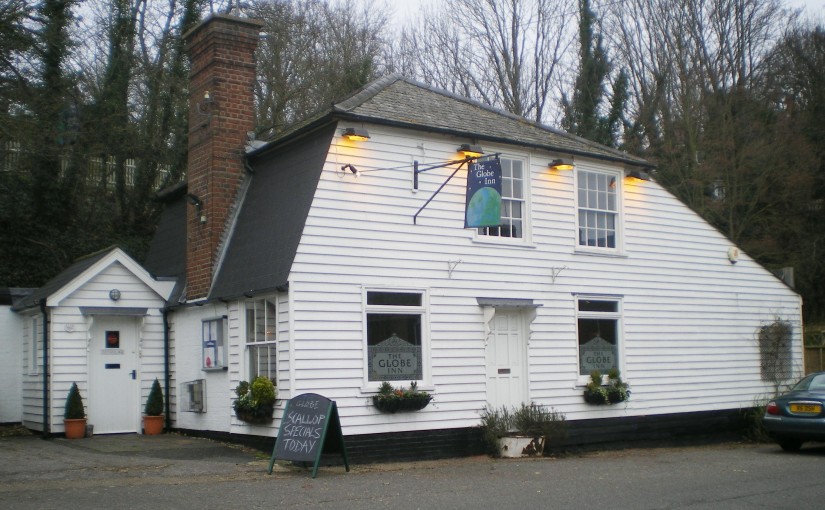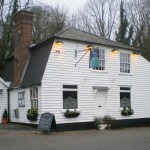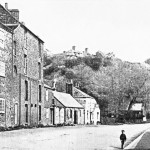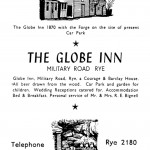The Pubs of Rye No. 4
The Globe Inn
by David Russell
The Globe opened in 1834 when a 50 year lease on this piece of land was granted to John Wheeler by the Reverend Lamb of Iden. John Wheeler, a beer retailer, then became the Globe’s first landlord. The lease included the cliff behind the pub which descends from Playden Heights, with its ‘pendants [overhanging parts] being part and parcel of the property’. A fairly large cave in the face of the cliff was also included in the lease. The annual rent was £127.
Four years later, in 1838, the pub was sold after John Wheeler had emigrated to Canada. At that time the Globe consisted of two parlours, a bar, tap room, skittle alley at the rear and four bedrooms to let.
In its early days the Globe was used by men employed on the maintenance of the Royal Military Canal which flows nearby, and after which Military Road is named. A sketch map of the canal from the early 1830s shows the Globe as an isolated building in a totally rural setting.
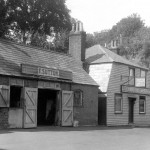
By the 1870s, adjacent outbuildings had become a forge and blacksmith’s shop on what is now the car park. Stables were established at the back as was an ever popular and now larger skittle alley. By now the Globe was using the old cave in the cliff face as the pub cellar. The cave cellar was featured in local guide books throughout the 1930s.
The Globe’s most popular and longstanding landlord was Marshall Ames, a busy and energetic man who ran the pub for 40 years from 1859–1899. As well as the Globe, he also had a building company involved in the development of the area in the last 30 years of the 19th century. When Marshall Ames died in 1899 the licence was transferred to Emily Ames, who ran the pub until 1903. Thus, the Ames family ran the Globe for 44 years making it the longest held family run pub in Rye.
One of the many clubs which came into existence at the turn of the century was the Globe Horticultural Club. Not surprisingly, in an area of cottage gardens and developing allotments, the subject of gardening among Globe customers was always a popular topic of conversation in the bar. Garden produce was first brought into the pub in about 1898, and from then on displays, particularly of flowers, were a regular Globe feature.
“The origin of the flower show was a squabble”, said the club chairman in 1903, “perhaps I ought to call it a discussion, as to who could grow the best dahlias. The discussion was a hot one and in the end we decided to have a Dahlia Show to see who could produce the best. After this we formed a Dahlia Club, later a Dahlia and Daffodil Club and from that it became the Globe Horticultural Club. I think that there is no town the size of Rye that could get a show better than ours in the winter months….” However, the club had serious competition from the Rye Gardeners who met and displayed garden produce at the Cinque Ports Arms.
In 1905 the local press commented:-
‘The healthy, profitable, and fascinating pursuit of cottage gardening was the all-absorbing theme at the Globe Inn on Tuesday evening, when the members and friends of the Globe Horticultural Club assembled on the occasion of their annual dinner. The old town of Rye is well served with organisations whose aim is to encourage gardening amongst cottagers in the district, and there are many who think that an amalgamation would be beneficial to all concerned. However this may be, the
Globe Horticultural Club has done its part in promoting keen and friendly rivalry amongst the working classes. During the summer and autumn months many excellent exhibits are staged at the Globe shows, and last year many specimens of fruit and vegetables shown were really remarkable, thus showing that the cottagers must have devoted a considerable amount of study to the various plants in order to discover the secrets of nature. This Club has sufficiently demonstrated its usefulness to commend it to the patronage of those interested in horticulture and the welfare of the working classes. We hope the Society, which has an enthusiastic president in Mr. Harry Davis, will meet with continued success.’
In 1898, the Globe became the headquarters of a branch of the Bonfire Boys, who by 1905 were known as the Military Road Bonfire Boys to distinguish themselves from other groups in the town. These groups were the antithesis, the direct opposite, of the Bonfire Boys which had plagued Rye for much of the 19th century. One writer described this change as: “the taming of the Bonfire Boys”.
By the 1920s the forge was occupied by Frederick Sutton a blacksmith from
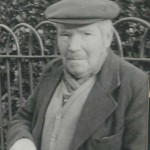
Speldhurst, Kent. But there were occupational dangers working here. I have recently been in contact with Frederick Sutton’s granddaughter Eveline Gillians who lives in Oxfordshire. She told me of “a wonderful letter written by my grandmother in early February 1929 saying “Dad seems very poorly, he was kicked black and blue by a colt last week”.
By 1920 the Globe was tied to the Finn Brewery of Lydd and conveyed to Style and Winch in 1921. The photograph of the Globe with Sutton’s forge next-door was taken between 1920 and 1922. The Sutton family were living at 3 Daniel Place, Military Road in 1929, (long since gone) and by 1933 both pub and forge were in the hands of Rye Corporation.
A full history of this historic pub can be found in the book 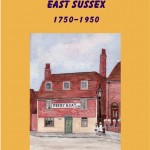 The Pubs of Rye, East Sussex 1750–1950 by David Russell. The book, illustrated with around 100 photographs, is in paperback, 282 pages, priced £13.99.
The Pubs of Rye, East Sussex 1750–1950 by David Russell. The book, illustrated with around 100 photographs, is in paperback, 282 pages, priced £13.99.
It is available at Martello Bookshop, Adams of Rye, Rye Tourism Information Centre, Rye Heritage Centre and Waterstones in Hastings. It is also available at www.hastingspubhistory.com, by email: [email protected] or phone 01424 200227.
I am collecting Rye pub memories and photographs for inclusion in any future edition.
Rye’s Own April 2013
All articles, photographs, films and drawings on this web site are World Copyright Protected. No reproduction for publication without prior arrangement. (Hard Copy Back Numbers Still Available) © World Copyright 2015 Cinque Ports Magazines Rye Ltd., Guinea Hall Lodge Sellindge TN25 6EG
